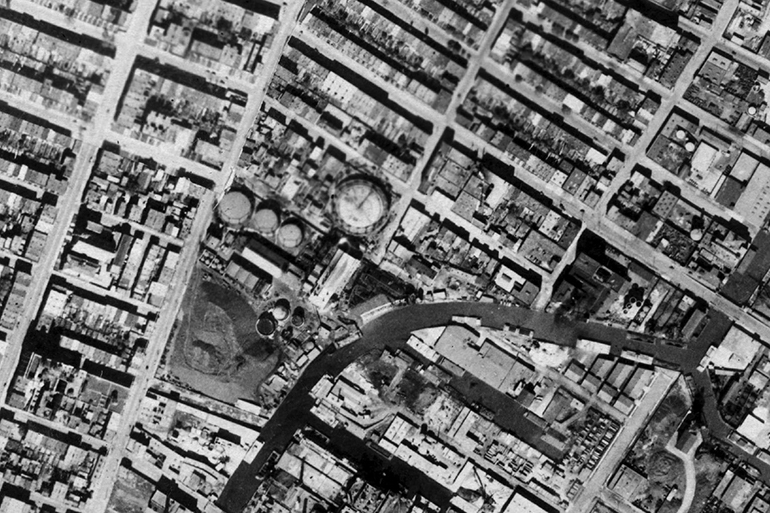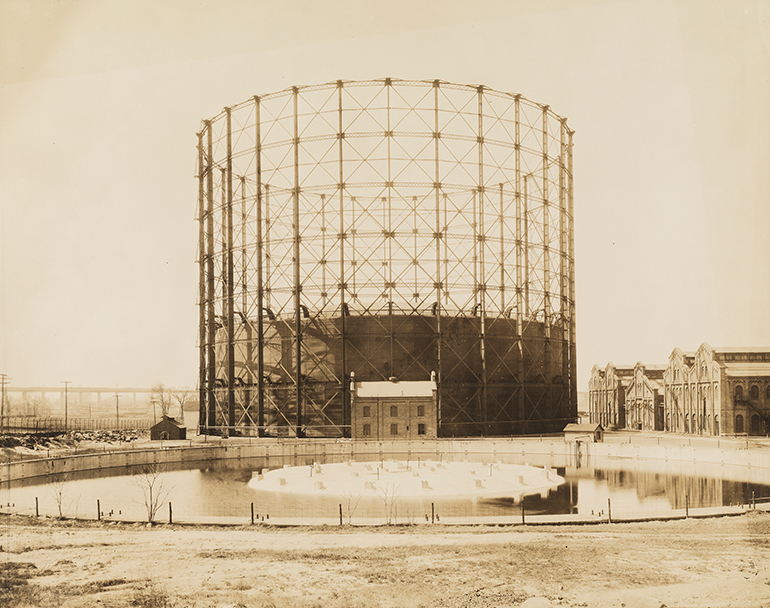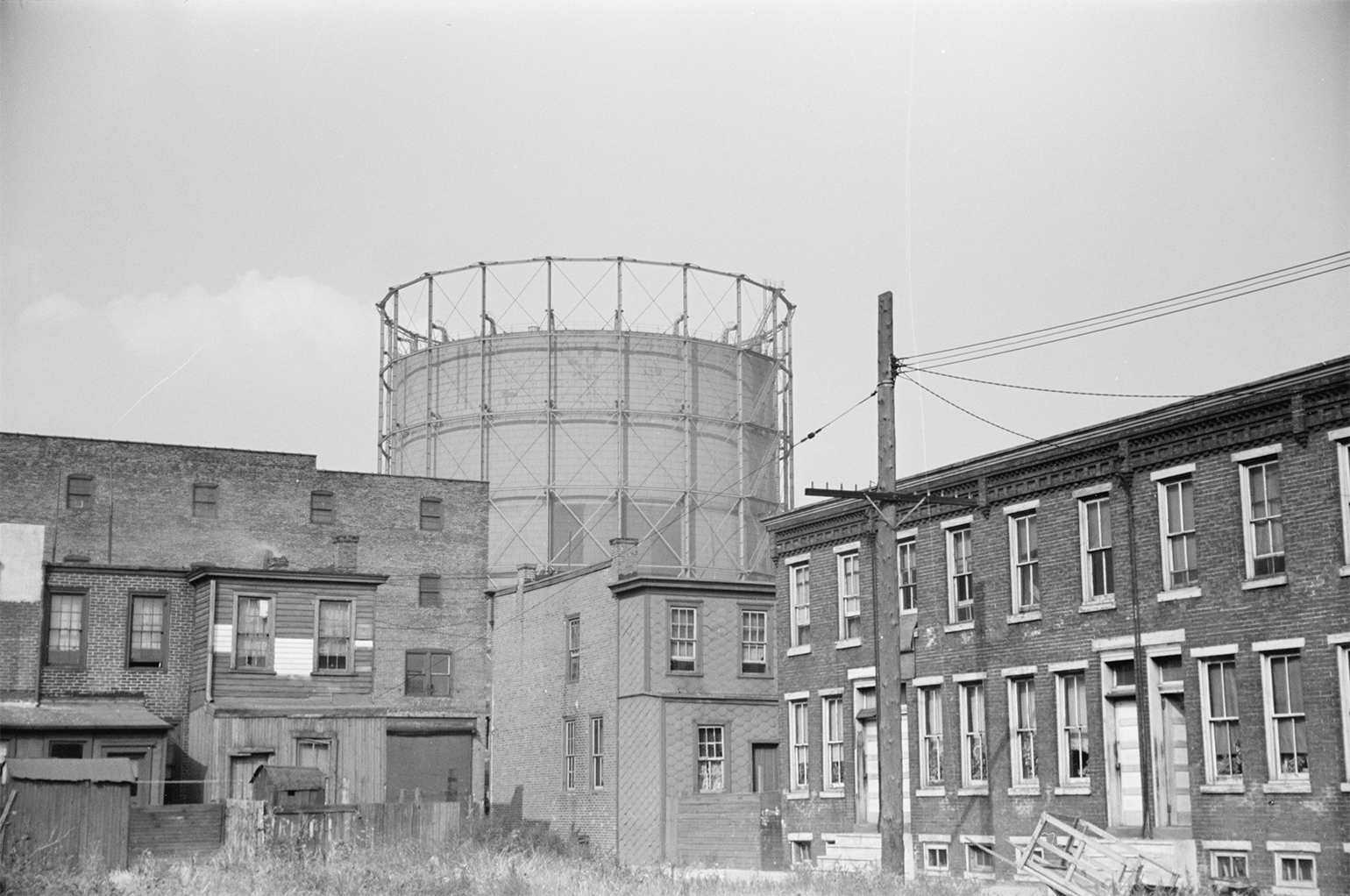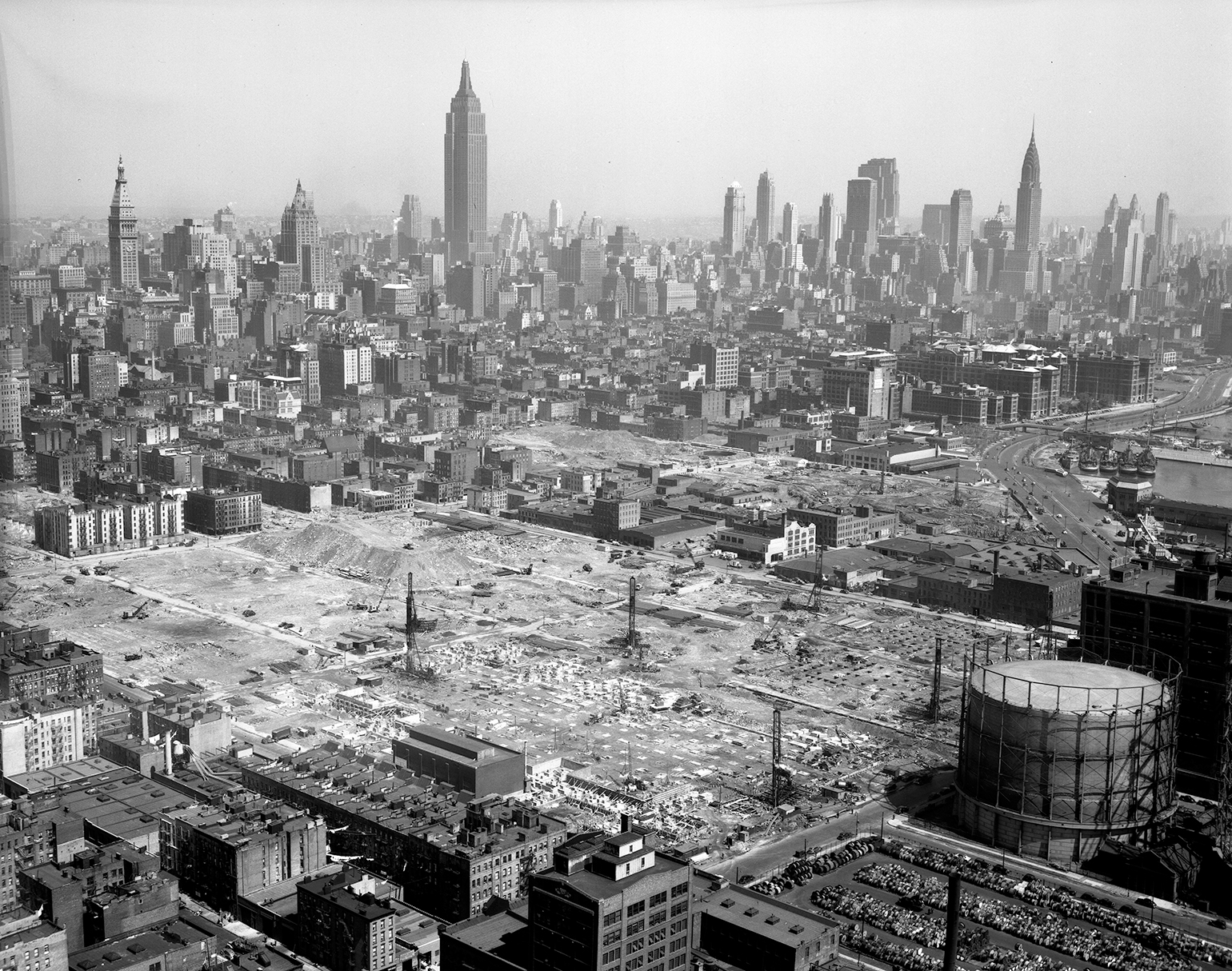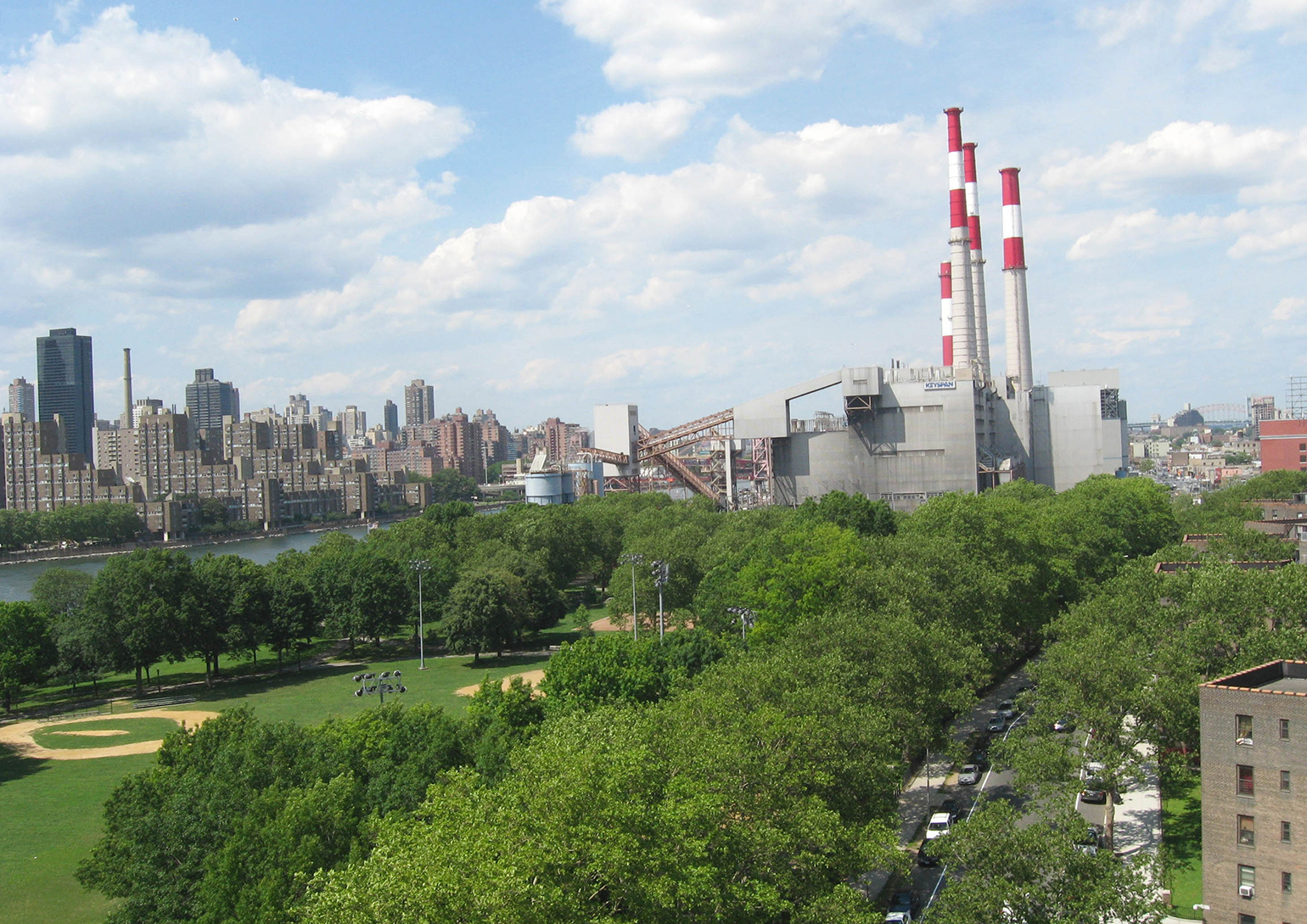Cleaning Up?
An exploration of what it means to live in, build on, and design for a city of pervasive toxicity.
We are celebrating 15 years — and counting — of stories that are deeply researched and deeply felt, that build a historical record of what the city has been.
Gas manufactured from super-heated (and super-noxious) coal provided US cities with light and heat for decades, before disappearing in a seeming flash. The gasworks and their characteristic circular storage containers have long been erased from the cityscape, but we’ve kept an eye on the system’s leaky legacies, and even followed transformations atop its former footprints. There are a few dozen former manufactured gas sites across New York City. Some lie fallow, while others have been fully rebuilt, home today to apartments, a hospital, a power plant. All are accounted for, and have either undergone remediation measures or await plans for mitigating their underground deposits of toxic coal tar residues. But this is far from the norm for cities across the country. Below, sociologists Jonathan Tollefson and Scott Frickel detail the manufactured gas plant’s disappearing act, the risks these hidden sites still pose, and the challenges to figuring out where they are located. An innovative computational pipeline could help finally find the traces of thousands of lost gasworks, the first step in contending with their hazardous remains. – MM
Walking through New York today, one would be hard-pressed to identify a single remnant of the city’s first gas industry. Hospitals, apartments, art galleries, housing projects, and parks now occupy former gasworks sites; other sites remain vacant, awaiting regulatory approval or the political will to remediate and redevelop. Yet the chemical legacies of coal gas remain very much a part of city life today, soaking the soils and groundwater of the five boroughs, as ecologically persistent as they are socially invisible.
Recent development proposals for the Gowanus Canal, historically one of New York City’s most notorious industrial dumping grounds, have sparked renewed interest in the enduring legacy of early municipal gasworks. The plans would replace light-industrial and commercial areas for mixed-use development, including substantial retail space and housing – some slated for a large city-owned lot on the east bank of the canal, home for over a century to one of the city’s many coal gasification plants. The plant is long gone — shuttered in the 1960s along with the rest of the city’s remaining gasworks — but its waste products remain in the form of a toxic soup of coal tar residuals extending up to 150 feet underground. A few blocks north, new construction along the canal would also cast its shadow over Thomas Greene Playground. Just seven feet of soil separate the playground from contamination associated with the former Fulton Municipal gas plant, which closed its doors in the early 1930s. Remediation at the playground is ongoing.
The gasworks once perched along the Gowanus Canal represent a small piece of a national network that transformed coal mined in Britain or Appalachia into combustible gas for use by city businesses and residents. Produced by super-heating coal, “manufactured gas” or “coal gas” provided the first citywide source of lighting and cooking fuel, enabling the massive urban and industrial expansion of the late-19th and early-20th century. As gasified coal was replaced by oil and natural gas by the end of World War II, the once-ubiquitous gasworks quickly became obsolete. They were soon demolished or redeveloped for other uses. Consequently, many sites of former coal gasworks remain hidden, with their legacy contaminants lurking below ground, socially invisible but ecologically ever-present.
Herein lies a dilemma. The contemporary Gowanus Green proposal crystalizes urban planners’ visions for a more sustainable and equitable urban future, even as the site’s historical legacy of coal gasification and toxic waste reveals the difficult truths that confound “green” dreams of ecologically benign redevelopment and design. For chemical residues, the past is never really past, but always inevitably part of our present and future, too.[1] How today’s planners and developers pursue plans for redevelopment depends in large part on what is known — and what remains unknown — about the environmental and industrial history of urban places.
Manufactured gas was first produced in the US around 1813, when some of the nation’s first gas lighting systems were installed in Rhode Island businesses. By 1860, nearly 400 individual gasworks had spread across the country; by 1910, that number had more than tripled. Manufactured gas came to New York City relatively early, starting in 1823 in Lower Manhattan, with gas lines soon extending north along the length of the island. By 1890, New York City’s Consolidated Gas Company was generating about 16 million cubic feet of gas daily across its multiple production sites. Within 15 years, through gasworks expansion and corporate acquisitions, the company more than tripled the productive capacity of its large gasworks portfolio.[2] Lighting the city also required the construction of a vast network of distribution lines, and by 1904 more than 2,500 miles of gas mains snaked under New York’s streets. Repurposed for natural gas in the mid-20th century, much of the subterranean infrastructure created to make and distribute coal gas more than a century ago remains in use today.
Extracting gas from coal was a messy business. Living near a gas plant meant contending with daily smoke, noise, and foul odors, as well as contaminated wells, clogged sewers, and the constant risk of accidental explosions and fire. Residents complained of lung, skin, and eye ailments, headaches, nausea, and a myriad other illnesses and diseases.[3] As a result, even as their gas lit the homes, factories, and businesses of the city’s industrial elites, gasworks sites were often epicenters of economic hardship, poor public health, and environmental risk of toxic exposures — conditions we now associate with environmental injustice.[4] The more than 11 billion gallons of toxic waste generated nationally by gasworks would remain largely unregulated until hazardous wastes sequestered on legacy sites finally became subject to federal regulation in the 1980s, decades after the industry and its many sites of production, storage, and distribution had disappeared.[5]
Reckoning with the manufactured gas industry’s legacy involves a complex set of challenges that plague remediation experts and urban planners. Simply finding the locations of old gasworks is a key hurdle. In the 1980s, just as the federal government was beginning to turn its attention to the growing crisis of industrial contamination, epitomized by the Love Canal toxic waste disaster in Niagara, New York, the Environmental Protection Agency (EPA) twice attempted to characterize the scale and spatial extent of the “lost gasworks” problem.[6]
The first study, completed in 1985, relied on information contained in historic coal gas industry directories. Brown’s Directory of American Gas Companies (among others published throughout the manufactured gas era) contains valuable information on the finances, production volumes, and technologies reported by individual gas companies. But industry directories do not include street addresses of gasworks plants and storage facilities, nor do they hold substantive clues about their actual, specific locations. Using this valuable but very limited set of historical data, the EPA study estimated the total number of former coal gasification plants in US cities to be around 1,500.[7]
Brown’s Directory of American Gas Companies, 1887, via Internet Archive
The following year, another EPA-commissioned study sought to locate gasworks sites in the states the EPA calls Region 10: Washington, Oregon, Idaho, and Alaska. By cross-referencing Brown’s Directory information from the 1985 study with thousands of historic fire insurance maps produced by the Sanborn Map Company, researchers confirmed the location of 35 former gasworks sites.[8] The study helped establish historic map research as a useful tool for uncovering the spatial history of coal gasification infrastructure.
Historic fire insurance maps provide urban historians and industrial archaeologists with meticulous documentation of a period marked by dramatic urban industrial expansion; but these documents are as unwieldy to work with as they are comprehensive. A single publication run for a medium-sized city may include hundreds of individual map pages; for larger cities such as New York, the number of pages can run into the thousands. For this reason, Sanborn maps are rarely used as a primary data source for large-scale site identification. Even the high-budget EPA effort to locate lost gasworks in the Pacific Northwest targeted large, centralized works run by utility companies using information from Brown’s Directory. As a result, the study missed smaller, neighborhood-level production and distribution sites, which nonetheless are likely to harbor significant levels of legacy contaminants. Later estimates put the total number of extant US gasworks at over 3,000, or more than double the 1985 estimate — and up to 50,000 if storage facilities and smaller gasworks, such as those built for individual factories, hospitals, prisons, and colleges, are included.[9]
Although the EPA never replicated the approach of the Region 10 study for the other forty-six states, the need to do so is still great. We have developed a method for identifying former manufactured gas sites that is faster, more comprehensive, and scalable to urban and regional geographies. This method marries the cartographic focus of the 1986 EPA study with computational tools that help to overcome the logistical challenges of large-scale map analysis. The result is Detect_MGP, a computational pipeline that combines image processing with machine learning applications to scan Sanborn maps for coal gas infrastructure. Rather than relying on prior information about where large gasworks serving as municipal utilities may have been sited, we can instead process large quantities of historic map images simultaneously, treating each city block as a potential host to lost or forgotten coal gas infrastructure.
Detect_MGP locates potential manufactured gas sites by scanning map images for cylindrical gasometers. The computational pipeline distinguishes between gasometers (above) and other, irrelevant circle-shaped features (below) using an artificial neural network.
We began our survey of former gasworks with a pilot study in Providence, RI. The results are striking: Not only did our analytical approach locate all the gasworks known to contemporary regulators, but the Detect_MGP pipeline found more than a dozen former gas sites that are not currently included in state or federal site monitoring databases. Today, those former gasworks sites host restaurants, houses, businesses, hospitals, and vacant lots.
We also applied the Detect_MGP pipeline to a collection of Sanborn maps for New York City, analyzing 2,130 map pages published between 1886 and 1903. We located 38 different manufactured gas sites: 36 municipal gas plants or district stations; one smaller, private gas plant; and one isolated gasholder likely associated with railway infrastructure. Gasworks pop up in every corner of the city, although the distribution of late-19th century plants generally followed population density: 18 gas sites were located in Manhattan or the Bronx (Sanborn cartographers mapped the two boroughs as a single unit), with an additional 13 in Brooklyn and six in Queens.
Similar to Providence, former New York gasworks sites today represent a mix of contemporary land uses. Many sites were converted soon after the end of the manufactured gas era: Stuyvesant Town, for instance, was constructed in 1947 atop the former East 17th and East 19th Street Stations and the East 14th Street gasworks; the Metropolitan Hospital Center was built in 1955 on the former site of the East 99th Street gasworks. All of them are visible to readers in the interactive map below; all but three have been located and mapped by researchers at the New York State Department of Environmental Conservation (DEC).
DEC has taken a uniquely aggressive approach to identifying and characterizing former gasworks statewide. Through research partnerships with Consolidated Edison (ConEd), which absorbed most of the state’s manufactured gas producers in the early 20th century, DEC has confirmed the location of more than 250 gasworks sites across the state of New York and estimates that another 50 or so sites remain to be identified. Efforts to characterize the specific nature of contamination at these sites are well underway. In a study initiated in 2004, DEC first located the extant gas production and storage sites formerly operating beneath Stuyvesant Town; the agency began investigating the Metropolitan Hospital Center site the following year. The Far Rockaway gasworks site has been undergoing remediation since at least 2015. Other sites are also in various stages of environmental remediation.
The three sites we found which were not listed in DEC’s database seem to represent anomalies. One was a smaller, privately owned gas plant listed in 1903 as belonging to the American Hard Rubber Company and situated on the southern edge of College Point in Queens. This former gasworks is not listed because it would have fallen outside the purview of sites managed by ConEd and other utility providers, past and present. Another site, an isolated gas storage building likely used for railway operations in Coney Island, also fell outside the purview of municipal gas production. Located opposite Roosevelt Island in Astoria, the third unlisted site belonged to the East River Gas-Light Company, according to the 1898 Sanborn map; the plant changed owners several times, finally landing with the Consolidated Edison Company sometime before 1947. As the manufactured gas industry declined over the following decades, ConEd gradually removed the site’s gasworks infrastructure and constructed Ravenswood Generating Station, the city’s largest electrical power plant, in its place. As is often the case, the manufactured gas history of the Ravenswood plant re-entered the public record when the deregulation of New York’s energy markets prompted its sale to KeySpan Energy in 1999 (Sanborn maps were key to the site history research that accompanied the transfer). We suspect that it is not included in the DEC database due to its ongoing use as an electrical power plant.
Dealing with coal gas residues on vacant land is relatively straightforward. Though it is difficult and nasty work, remediation is generally successful given enough money, time, engineering, and heavy equipment. The calculus shifts, however, for sites long since redeveloped. Instead of removing buried contaminants wholesale, agencies generally adopt an aggressive monitoring strategy combined with the slow removal of gas wastes using passive recovery wells. The Stuyvesant Town case provides an instructive example: Following several years of soil, groundwater, and air testing in the early 2000s, DEC concluded that coal gas residues on the site are limited to soils at least five feet below ground level. The challenge at Stuyvesant Town, however, is ensuring that the five feet of soil separating past from present remains undisturbed. In such cases, perhaps, “remediation” is more about economic and political considerations than it is about questions of engineering and infrastructure.
Red hot real estate markets, inflated land prices, and a motivated regulatory environment mean that New York’s zest for, and success in, recovering lost gasworks sites is somewhat unique nationally. Providence — more representative of the post-industrial decline and halting rebound experienced by industrial cities and mill towns in the Rustbelt and Northeast — tells a different story, with starker implications for cities whose history of coal gasification remains buried and forgotten.
The contrast between the two cities underscores the important but easily underappreciated truism that urban change is an ongoing, historical process: What matters are not only the outcomes of urban redevelopment, but also the different paths leading to those outcomes. Because legacy contaminants are often discovered when properties are sold and redeveloped, the discovery process varies according to local dynamics of urban land use and property sales as much as by regional- or state-level policy decisions. This means that properties in high-volume, high-value real estate markets like New York City are more likely to have their site histories investigated as they cycle through rapid periods of turnover than those in slower-moving markets. Where early patterns of “socioenvironmental succession” buried former gasworks beneath multiple iterations of land use and reuse, more recent redevelopment projects — beholden to relatively new investigation and remediation requirements — scrape away some of the accumulated archival-archaeological layers — if we know where to look, and care enough to make the effort.
Most critically, the long-vanished coal gas industry reveals how historical processes of industrialization and urbanization pushed people and toxins into ever-closer proximity as cities and factories grew up together. The people and neighborhoods have changed over generations, and the older industries have mostly disappeared, but the contaminants those factories left behind have not. Like ghosts suspended between worlds, they haunt the city and the unsuspecting residents who today call those places home.
The authors' research is supported by the Superfund Research Program of the National Institute of Environmental Health Sciences, grant P42ES013660.
Soraya Boudia, Angela N.H. Creager, Scott Frickel, Emmanuel Henry, Nathalie Jas, Carsten Reinhardt, and Jody A. Roberts, Residues: Thinking through Chemical Environments (New Brunswick: Rutgers University Press, 2021).
Ernest C. Brown, Brown’s Directory of American Gas Companies (New York: Progressive Age, 1890 and 1904).
Joel A. Tarr, “Toxic Legacy: The Environmental Impact of the Manufactured Gas Industry in the United States.” Technology and Culture 55, no. 1 (January 2014): 107–47.
Peter Thorsheim, Inventing Pollution: Coal, Smoke, and Culture in Britain since 1800. (Athens: Ohio University Press, 2006).
Radian Corporation, “Survey of Town Gas and By-Product Production and Locations in the US (1880-1950),” EPA-600/7-85-004. US Environmental Protection Agency, 1985.
Adeline Gordon Levine, Love Canal: Science, Politics, and People (Washington, DC: Lexington Books, 1982).
Radian Corporation, “Survey of Town Gas and By-Product Production and Locations in the US (1880-1950),” EPA-600/7-85-004. US Environmental Protection Agency, 1985.
Ecology and Environment Inc. “Coal/Oil Gasification Site Study, Region X.” TDD R10-8405-03. Seattle, WA: US Environmental Protection Agency, 1986.
Jay H. Lehr, Marve Hyman, Tyler Gass, and William J. Seevers, Handbook of Complex Environmental Remediation Problems (New York: McGraw-Hill Education, 2002); Allen W. Hatheway, Remediation of Former Manufactured Gas Plants and Other Coal-Tar Sites (New York: CRC Press, 2012).
The views expressed here are those of the authors only and do not reflect the position of The Architectural League of New York.
An exploration of what it means to live in, build on, and design for a city of pervasive toxicity.

